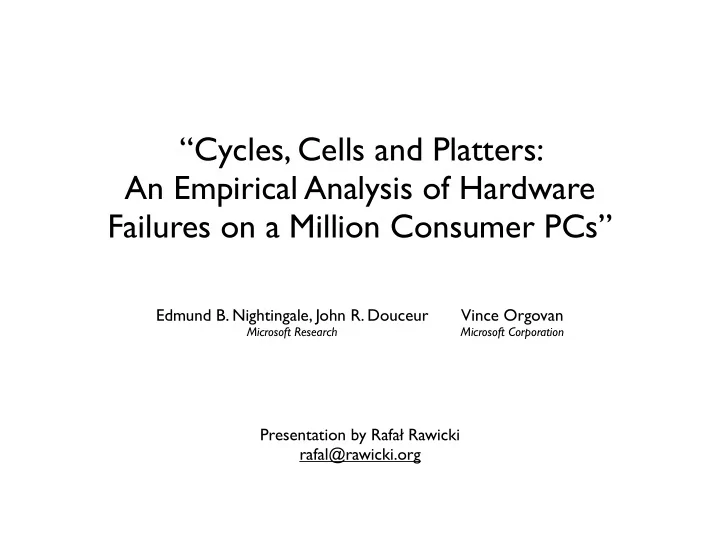

“Cycles, Cells and Platters: An Empirical Analysis of Hardware Failures on a Million Consumer PCs” Edmund B. Nightingale, John R. Douceur Vince Orgovan Microsoft Research Microsoft Corporation Presentation by Rafa ł Rawicki rafal@rawicki.org
Introduction • This is the first large-scale analysis of hardware failures on consumer PCs • Two data sets: • RAC - from Windows’ Experience Improvement Program (collected from approx. 950 000 machines) • ATLAS - from reports sent when Windows boots after crash
Data limitations • Only Windows crashes were reported. There is no data about unrecoverable failures or application crashes. • Opt-in participation in both programmes.
Terminology • TACT - Total Accumulated CPU Time • Failures divided by type of hardware: • CPU and associated components • DRAM • disk subsystem
Failures are recurring Failure min TACT Pr[1st failure] Pr[2nd fail | 1 fail] Pr[3rd fail | 2 fails] CPU subsytem 5 days 1 in 330 1 in 3.3 1 in 1.8 CPU subsytem 30 days 1 in 190 1 in 2.9 1 in 1.7 DRAM one bit flip 5 days 1 in 2700 1 in 9.0 1 in 2.2 DRAM one bit flip 30 days 1 in 1700 1 in 12 1 in 2.0 Disk subsystem 5 days 1 in 470 1 in 3.4 1 in 1.9 Disk subsystem 30 days 1 in 270 1 in 3.5 1 in 1.7
Underclocking vs. overclocking Vendo endor A Vendo endor B No OC OC No OC OC Pr[1 st] 1 in 400 1 in 21 1 in 390 1 in 86 Pr[2nd | 1] 1 in 3.9 1 in 2.4 1 in 2.9 1 in 3.5 Pr[3rd | 2] 1 in 1.9 1 in 2.1 1 in 1.5 1 in 1.3 Underclocked Rated CPU subsystem 1 in 460 1 in 330 DRAM one-bit flip 1 in 3600 1 in 2000 Disk subsystem 1 in 560 1 in 380
Desktops vs. laptops Desktops Laptops CPU subsystem 1 in 120 1 in 310 DRAM one-bit flip 1 in 2700 1 in 3700 Disk subsystem 1 in 180 1 in 280
Interdependence of failure types DRAM failures no DRAM failures CPU failures 5 (0.549) 2091 (2100) no CPU failures 250 (254) 971,191 (971,000) Disk failures no Disk failures CPU failures 13 (3.15) 2083 (2090) no CPU failures 1452 (1460) 969,989 (970,000) Disk failures no Disk failures DRAM failures 1 (0.384) 254 (255) no DRAM failures 1464 (1460) 971,818 (972,000)
Summary System Topic Finding CPU initial failure rate 1 in 190 DRAM initial failure rate 1 in 1700 Disk subsystem initial failure rate 1 in 270 CPU rate after first failure 2 order-of-magnitude increase DRAM rate after first failure 2 order-of-magnitude increase Disk subsystem rate after first failure 2 order-of-magnitude increase almost 80% machines had a recurrence at the same DRAM physical address locality address all failure memorylessness failures are not Poison all overclocking failure rate increase 11% to 19% all underclocking failure rate decrease 39% to 80% all brand name / white box brand name up to 3x more reliable all laptop / desktop laptops 25% to 60% more reliable
Summary System Topic Finding cross CPU / DRAM dependent cross CPU / Disk dependent cross DRAM / Disk independent CPU increasing CPU speed fail. incr. per time, const per cycle DRAM increasing CPU speed failures increase per time & cycle Disk subsystem increasing CPU speed fails incr. per time, decr. per cycle CPU increasing DRAM size failure rate increase DRAM increasing DRAM size failure rate increase (weak) Disk subsystem increasing DRAM size failure rate decrease CPU calendar age rates higher on young machines Disk subsystem calendar age rates higher on old machines all intermittent faults 15%-39% faulty machines
Other interesting works • Bitsquatting - DNS Hijacking without exploitation Artem Dinaburg, July 2011, Raytheon Company • DRAM Errors in the Wild: A Large-Scale Field Study, June 2009, Google
Bitsquatting • Some domains differing by one bit from popular ones were aquired
Bitsquatting • Experiment took approx. 8 months • “(...) a total of 52,317 bitsquat requests from 12,949 unique IP addresses.”
DRAM Errors in the Wild
DRAM Errors in the Wild • ECC chips only • Recurrence probability is consistent with “Cycles, Cells and Platters (...)” • “A DIMM that sees a correctable error is 13–228 times more likely to see another correctable error in the same month” • Error rate increases with age
Alpha Particles
Thank you
Recommend
More recommend